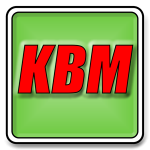 Far be it for me to name a “method” after myself. I suppose it would be okay, but I didn’t do it! In fact, the designation Kevin Brown Method (or simply KBM) eventually grew to encompass three different methods; a procedure designed to deliver increased cutting and better final polishing using a random orbital; another method designed to maximize the cutting power of a Surbuf Microfingers Pad paired with a random orbital; and still another designed to improve the cutting potential of a rotary polisher.
Far be it for me to name a “method” after myself. I suppose it would be okay, but I didn’t do it! In fact, the designation Kevin Brown Method (or simply KBM) eventually grew to encompass three different methods; a procedure designed to deliver increased cutting and better final polishing using a random orbital; another method designed to maximize the cutting power of a Surbuf Microfingers Pad paired with a random orbital; and still another designed to improve the cutting potential of a rotary polisher.
My now good friend (and high-end detailer) Todd Helme inadvertently coined the phrase while writing a thread about several cars he had recently detailed. In the thread, he simply mentioned that he had used Kevin Brown’s Methods of Madness to polish a 1948 Lincoln Zephyr. It was a big deal to him at the time, because he was able to achieve results using the random orbital that he simply did not envision were possible. Immediately after posting his statement, people wanted to know: “Who is Kevin Brown, and what is his method?” I was certainly happy to share the information with others, and eventually wrote two additional articles.
Check out the the Kevin Brown Method for yourself. Perhaps there are few tips listed in the articles that will help you, too!

I can’t begin to tell you how the KBM has changed the paint correction world for me. I have not used a rotary in over 3 years. Thanks to Kevin for his vast knowledge and thinking “outside of the box.”
Kevin,
Thanks for all the ways you have changed the detailing industry. You’ve allowed me ti always keep an open mind and realize theres not just one way to level paint!
Bryan, you were among the first to give the random orbital an honest shot by laying down your rotary and trying the Surbuf and M105… I like the fact that you are open to new ideas and techniques. It’s one of the reasons why you are considered “tops” in the detailing world.
Barry, you have a way of asking questions that force me to write hour-long responses… which you know I like to do!
I remember the first time that I read todd’s article about the KBM method. The rotary is an awesome tool for orange peel removal with wool and the new denim and velvet pads I use in my shop, but a powerful D/A and the random orbitals of this industry have bridged the gap immensely.
They haven’t totally eliminated the need for a rotary, as the heat from a rotary can create more depth and gloss as well as have the ability to fuse deep straight line and curved scratches out completely and even bird drop etching. There is more to paint perfecting than just removing scratches and swirls; as re-finishers of paint, we are purifying paint, removing orange peel, correcting defects, and making the paint thicker.
With a rotary, D/A, random orbital and drum-style polishers, and microfinger, microfibre, foam, foamed wool, 1ply and 4 ply wool, silk, denim and velvet buffing pads, there isnt much us detailers can’t fix.
Matthew-
We do have many choices nowadays.
Regarding our notion that heat (as created by the rotary), is a good thing… I am not in agreement that it can create more depth and gloss than a proper polishing using the lowly random orbital.
It this were true, guys way before you would have been pre-heating panels, working in paint-setting ovens, all the while wearing their fully enclosed, air conditioned cooling suit.
Many of us wouldn’t have a need for all that anyway- we could simply park the car in the sun, and get to hand rubbing! You might be surprised how hot a dark can can get on a warm & sunny summer day.
Anyway, thanks for reading.